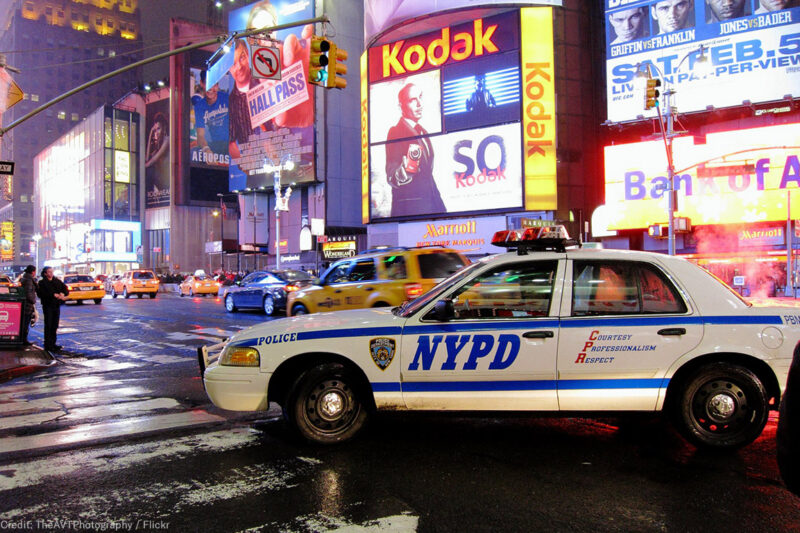
New Yorkers know that the New York Police Department will treat us differently depending on our zip code and the color of our skin. But many New Yorkers don’t know the intensity and the violence of police contact in neighborhoods heavily targeted by the NYPD.
A new report from the NYCLU exposes the radically different ways in which NYPD officers behave depending on what neighborhood they’re working in and the impacts of that discrimination on everyday New Yorkers. “Shattered: The Continuing, Damaging, and Disparate Legacy of Broken Windows Policing in New York City” is based on the findings of an NYCLU survey that documents the disparate impacts of policing on heavily policed and lightly policed communities. It may surprise you to know that neighborhoods across New York City have similar rates of serious crime, especially given how astoundingly different the police treat them.
But our survey reveals a tale of two cities when it comes to policing.
Nearly nine out of 10 survey respondents in heavily policed communities said they actively changed things about their behavior, relationships, use of space, or schedule to avoid police surveillance. Nevertheless, almost half of respondents in heavily policed communities said the police wrongly accused them of committing a crime. And nearly one in five respondents in heavily policed communities reported at least one incident of sexual harassment by police versus five percent for those in lightly policed neighborhoods.
Fear of police violence is also pervasive, which is maybe why nearly half of respondents in heavily policed neighborhoods reported that calling police for help would actually make a situation worse. Only 16 percent of those in lightly policed areas held that view.
More than a third of respondents in heavily policed communities reported enduring extreme physical force from police, compared to just four percent in lightly policed communities. More than two-thirds of respondents in heavily policed communities, according to the survey, feared having a friend or family member killed by police. Fifteen percent of respondents in lightly policed communities felt the same way.
These results should alarm anyone who thought the era of aggressive, invasive, and counterproductive policing in New York City was over. They contradict the NYPD’s constant refrain that officers go where the crime is and that the people in heavily policed neighborhoods feel safer with their neighborhoods flooded with officers.
To understand why these findings are so vital, we should look back to a few years ago. In 2013, now New York City mayor Bill de Blasio successfully billed himself as “the only candidate to end a stop-and-frisk era that targets minorities.” Stop-and-frisk — the practice of stopping and questioning people in public and subjecting them to searches of their bodies, often invasively and often without cause — had become widespread under the Michael Bloomberg administration as did public anger over the tactic. Stop-and-frisk was also the subject of litigation, including a successful NYCLU case that helped curtail the practice.
But five years later, the NYPD is still treating people differently, interfering with parts of their lives that have nothing to do with public safety.
Part of the problem is the mayor’s continued adherence to “Broken Windows” policing. Our report is a stinging indictment of the failed practice, which posits that if minor crimes are allowed to happen in a neighborhood with visible signs of neglect —such as broken windows — then it will lead to more disorder and eventually to serious crime. The theory basically says that in order to keep people safe, you have to police their every move.
In practice, Broken Windows has been used as cover for discriminatory policing and harassment of communities of color for decades. Mayor de Blasio has been totally unequivocal in his support for broken windows policing. This has to change. The people we spoke to chart a path forward — away from discriminatory policing by officers who are too often not held accountable and toward healthier, stronger communities that don’t live in fear of the NYPD.
Our survey didn’t just ask people about policing, we asked what they wanted to see in their neighborhoods to make them better. People’s answers usually had nothing to do with policing. Folks in both types of communities said they wanted things like quality schools and good-paying jobs.
Perhaps most revealing, neither community prioritized needing more police in their neighborhoods. There was not majority support for increases in any policing activity, surveillance, or in the number of officers. In fact, 44 percent of those living in heavily policed communities and nearly a quarter living in lightly policed communities actually wanted fewer police in their neighborhood.
The findings in our report are the result of an in-depth survey that collected answers to hundreds of questions from nearly 1,500 New Yorkers in neighborhoods across the city. It is likely the most comprehensive study of police interactions during the de Blasio era in terms of the amount of information collected.
You can see our recommendations for reforms that would require police to tell people their rights, uncover police surveillance, and keep the NYPD from hiding police misconduct in the full report.

